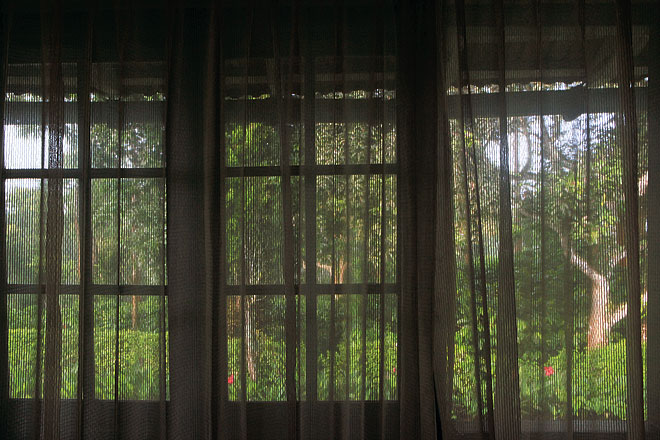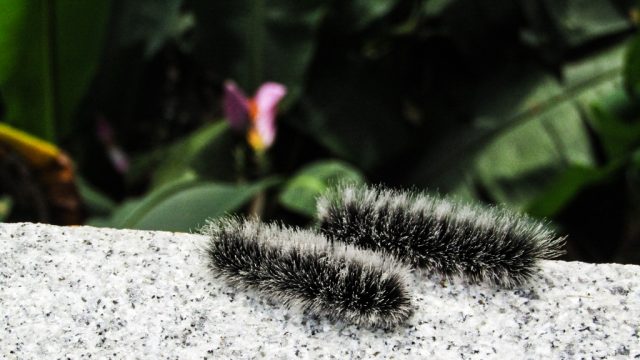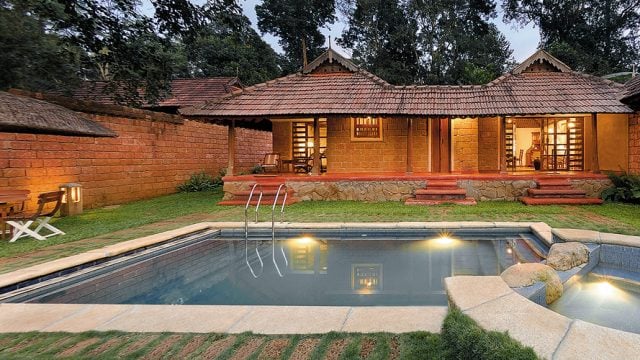There’s a staccato tap-tap-tap on the glass bay window at breakfast time, and in the quiet stillness
Of such joyous interactions with birds and beasts, I had plenty during the three days that I whirled around in Coorg recently. Despite promise of plentiful rain, the days were for the most part gloriously sunny, and all of nature’s bounteous creations seemed to have been spiritually uplifted by the clement weather. In the spirit of things, a spangled moth had taken up temporary residence in my retro-design bathtub; given the vastness of my room and the facilities in the colonial-era bungalow I was luxuriating in, I was happy for her company.

The 128-year-old Cottabetta Bungalow in Coorg—one of a string of heritage (and swank!) plantation bungalows owned and managed by Plantation Trails, a hospitality initiative of Tata Coffee Ltd—is geared for laidback luxury. In an earlier time, the property, perched on top of a hill that commands spectacular sunrise and sunset views, served as the official residence of the chairman of what is today the world’s largest integrated coffee plantation company. Restored to lofty luxury (while simultaneously retaining its old-world charm), the Cottabetta Bungalow—along with six other Plantation Trails bungalows in Coorg (and one more in Chikmagalur)—is today open to discerning visitors who seek out quiet indulgence in this thickly wooded region of the Western Ghats. Also in an earlier time, a fire would be lit in a faraway village, across many layers of hills, to alert the sharp-eyed estate service staff to the imminent arrival of guests; today, however, far less incendiary methods are invoked: a flurry of e-mails did it for us.

My days and nights at the Cottabetta Bungalow, and later at the Thaneerhulla Bungalow (to which I adjourned), were punctuated by the slow rhythms of life and supreme gratification of both body and mind. My mornings began to the chirruping of early birds in the surrounding plantations, and the heady aroma of a steaming cup of filter coffee served by my bedside. The coffee is a happy, soul-stirring blend of Arabica and Robusta, both of which grow in the natural forest environment of the Tata Coffee estates—unlike tea, which requires entire hillsides to be denuded of trees and manicured to a nicety. And since that natural forest ecosystem includes a profusion of cardamom, pepper and vanilla plants and creepers (in addition to towering silver oak and rosewood trees), the coffee appeared to me to come laced with the whiff of these ghati spices. Either that or my consciousness was high on caffeine.
One evening, when my travelling companion Rashmirekha was nursing a headache, the attentive service staff instantly whipped up a home remedy in the form of a hot cup of bellakaapi, or black coffee with a pinch of pepper, ginger and jaggery. It worked like a charm, and she was back to peak selfie form in a trice.
I could have dawdled around in the bungalow all day—the armchair in the foyer was comfortably sloth-inducing—and I’d never have complained. In fact, I’m reliably told that most visitors here do nothing more strenuous than potter around the place, soaking in an enviable state of ‘non-doing’, and absorbing the many sounds of silence. The masterly exertions of chef Manjunath Shivanna, who plied us with noolputtu (string hoppers) with chicken curry one night and another delectable Kodava speciality the next, further disincentivised any form of locomotion away from the premises.
And yet, stir out we did, under the persuasive coaxing of naturalist Andy Mohan, who assured us that there was a whole new world out there waiting to be explored. We proceeded one morning to the Dubare Elephant Camp, where elephants captured in the wild have been ‘tamed’ and trained and housed under a Karnataka Forest Department project. Watching the gentle beasts friskily disporting themselves in the water and at mealtime, with only minimal mahout intervention, it’s hard to believe they once belonged to the wild herds that are legion in the region. Tusker intrusions into human spaces are a fact of daily life in Coorg—although, of course, there is arguably a case to be made that it is humans who are intruding onto the elephants’ turf. Fatalities are occasionally reported, and virtually everyone we met and interacted with at the cottages had an experience to narrate of a close encounter with a wild elephant. But as if to underline that this elephant camp belonged in another, less-grim universe, an impish baby elephant, emerging fresh from her bath in the Cauvery, squirted a group of us onlookers with the water she had secreted away in her trunk.

Our next stop was at the Namdroling Monastery in Bylakuppe, which is home to India’s second-largest Tibetan Buddhist community (after Dharamsala). The monastery is a serene campus with three towering images of the Sakhyamuni, the Amitabha Buddha and Guru Padmasambhava, considered an emanation of the Amitabha Buddha. The meditation hall at the monastery is a becalming centre of spiritual energy. But on a walkabout of the surrounding garden, I was greeted by a far less austere (but nevertheless endearing) sight: of young, berobed monks swinging from trees, like naughty kids in any schoolyard at recess time. The shriek of mischievous laughter rose gaily into the air, piercing the quietude. “Tashi delek,” I greeted them in Tibetan. They eyed me warily for a moment, but overcome by child-like curiosity, they scampered down one by one and lined up to interact. They were from Nepal, and when I told them I had been to the Potala Palace of the Dalai Lama, in Lhasa, they became round-eyed with vicarious amazement. By the end of our interaction, they had thawed sufficiently to allow themselves to be photographed.
We drove through the Nagarhole National Park, and although the safari excursion we had booked for had been cancelled for fear of rains (which never came), we chanced upon groups of chital, a wild boar and a langur in the forest.
Returning to the Cottabetta Bungalow, we were in for a royal repast that Shivanna had prepared for us: the Kodava speciality pandhi curry (the distinctively Coorgi pork dish) with kadambuttu (rice balls). Faithful to his culinary tradition, he had marinated and tenderised the pork meat and infused it with the aromas and the flavours of garden-fresh pepper and other spices. The offering, when it came to the table, was succulent and yet not overly rich. An unlikely hush descended over our otherwise chatty table as the gourmet dish went down like greased lightning.
After another day of excursions—this time to Talakaveri, the origin of the Cauvery River, and to Madikeri—we returned to the Thaneerhulla Bungalow (to which our luggage had seamlessly moved), which was only slightly newer at a stately 125 years. I was wonderstruck by the realisation that my room here was even bigger than the one at Cottabetta Bungalow. These bungalows don’t stint on space, and everything about the artfully done up property is characterised by refined elegance and an opulence that doesn’t have to proclaim itself.
As a light rain fell over Coorg, I grabbed a coffee table book on the region, and over endless cups of kaapi, immersed myself into the life of the local folks who, for all their peaceable manner, have a distinguished martial record. Over dinner, the service staff regaled us with the peculiarities of their Kodava tribal life. In particular, much merriment was induced by their narration of the accounts of the ‘Kunde Hubba’ festival, during which the norms that govern social interactions are waived: transvestism is common, and in bouts of inebriation, folks go around cursing everyone, including their employers and even the gods!

The next morning, our last in Coorg, was a bit overcast, which wasn’t propitious for the birdwatching expedition that Plantation Trails naturalist Uday had lined up for us. Still, the weather was bracing, so we headed out, just happy to be outdoors in so glorious a place. But sun or no sun, the bird species of Coorg—of which there are about 300—were tripping over themselves in order to reveal themselves to us. Every 20 paces or so, Uday would motion us into silence, and listen keenly; occasionally he would mimic birdcalls. Before long, we had lined up an array of bird sightings: serpent eagle, wagtail, moorhen, the Malabar grey hornbill, a rare white-bellied woodpecker, scarlet minivet, magpie robin, ashy wood swallow, the vernal hanging parrot, the white-cheeked barbit…
It wasn’t just the birds; Uday’s gifted sensory perception also opened up for us the world of such exotic species as tunnel spiders and even plants: he tore off a frond of the jatropa plant (famed for its biofuel properties) and taught us to blow bubbles from the sap.

At one point, Uday broke off in mid-sentence and darted into the undergrowth. Curious, I followed him stealthily and espied him stalking a very jumpy toad. The extravagantly coloured amphibian, enjoying the advantage of turf superiority, was planning to escape by going around a coffee bush, but I moved agilely to cut off his route, causing him to pause momentarily. In a flash, Uday caught him up tenderly in his cupped hands, and after calming him sufficiently by blowing on him, exhibited the specimen, who then sat gamely for us to admire his splendour. It was a tiny toad from the Clinotarsus family, and the sight of such a tender creature preening himself for our pleasure seemed to encapsulate for me the limitless beauty and joy of nature. It was a mystical moment: beautiful, blessed Coorg, it appeared, had, however fleetingly, made me one with the universe.
The information
Getting there: The airports nearest to Coorg are Mysore (120km/3hr by road) and Mangalore (150 km/3.5hr by road), but you have many more air services to Bengaluru (260km/6hr by road). The nearest railheads are, again, Mysore and Mangalore. I flew Delhi-Bengaluru on IndiGo (economy return fares start at about Rs 11,000), and took a cab (about Rs 6,000).
Where to stay: I stayed as a guest of Plantation Trails, a hospitality venture of Tata Coffee, at its Coorg coffee plantations. Plantation Trails offers eight properties across three categories of accommodation in Coorg and one in Chikmagalur. I stayed at both the Premium Heritage Bungalows in Coorg: the Cottabetta Bungalow, a 128-year-old property that’s been restored to ultra-luxury standards, and the Thaneerhulla Bungalow, which is of 125-year vintage.
The five-room Cottabetta Bungalow can be hired for Rs 50,000 (plus taxes) a night; individual room rates start at Rs 9,500 (plus taxes). The Thaneerhulla Bungalow, which too has five rooms, can be hired for Rs 45,000 (plus taxes) a night; individual room rates start at Rs 9,500 (plus taxes). Includes stay and breakfast and other experiences offered by Plantation Trails. Details of tariff for the other properties and bookings at www.plantationtrails.net; reach. [email protected]; 080-23560761; +91-9900212119.
What to see & do: A big part of coming to Coorg is about putting your feet up, but Plantation Trails also offers guests a complete ‘plantation experience’ for free, including a plantation safari, a bean-tocup experience (where guests pick the berries and see them through the processing stage till it becomes a steaming cup of coffee in their hands), a nature walk and birdwatching tour, and access to a 9-hole golf course (caddie service charge: Rs 500).
You could take day excursions to the Dubare Elephant Camp, some 40km from Coorg, and watch elephants being bathed and fed. Visit the Namdroling Monastery, a centre of Tibetan Buddhism, in Bylakuppe. Talakaveri, the source of the Cauvery, is about 50km from Coorg; walk some 365 steps up from the temple there, and you get a spectacular 365-degree view of the surrounding hills. Swing by Madikeri, where the Raja’s Seat offers a scenic sunset view.
Homestays in Coorg
places to stay in Coorg
plantation bungalow in Coorg
Leave a Reply
You must be logged in to post a comment.




